Eco-Friendly Pest Control Approaches for Handling Wild Animals in Urban Locations
Urban locations usually discover themselves at the intersection of human task and wildlife, leading to distinct obstacles in pest administration. These methods not only protect the atmosphere yet likewise boost neighborhood engagement in wildlife administration. As metropolitan populaces proceed to expand, understanding the characteristics of wild animals communications ends up being progressively critical.
Comprehending Urban Wildlife Characteristics
Recognizing Urban Wild animals Characteristics is crucial for creating reliable and environmentally friendly insect control methods. Urban areas are increasingly coming to be environments for different wild animals types, driven by variables such as environment fragmentation, food availability, and human advancement. Recognizing these characteristics allows for a nuanced technique to pest administration that straightens with ecological concepts.
Urban wild animals commonly consists of types such as raccoons, squirrels, and birds, which adjust to city atmospheres, discovering particular niches in environment-friendly spaces, parks, and also household areas. Their presence can bring about conflicts with people, specifically when they exploit personnels for food and sanctuary. Recognizing the behaviors and eco-friendly roles of these species informs methods that lessen unfavorable interactions while advertising biodiversity.
Furthermore, recognizing the interdependencies within metropolitan ecosystems assists in determining vital areas for habitat conservation and restoration. This knowledge adds to the advancement of integrated parasite administration (IPM) strategies that think about the eco-friendly balance, consequently minimizing dependence on unsafe chemicals. By promoting coexistence in between people and metropolitan wild animals, cities can produce healthier settings that profit both residents and regional communities, paving the way for lasting metropolitan living.
Natural Repellents and Deterrents
All-natural repellents and deterrents use a lasting option to traditional parasite control techniques by taking advantage of the power of nature to keep unwanted species away. These eco-friendly solutions typically make use of plant-based ingredients, vital oils, and various other normally occurring compounds that deter insects without harming the setting.
One effective natural repellent is peppermint oil, which is recognized to repel rats and pests. Its solid fragrance is unpleasant to several bugs, making it a prominent selection for urban setups. Likewise, vinegar and citrus peels can function as deterrents, as their solid odors are usually unattractive to various wild animals.
Additionally, diatomaceous planet is a natural powder that can be spread out in locations susceptible to insect task, efficiently drying out and hindering pests without posing threats to non-target varieties. Additionally, garlic sprays and neem oil are acknowledged for their capability to push back a large range of insects, including both insects and bigger wild animals.
Applying these all-natural repellents not only reduces reliance on chemical pesticides but likewise advertises a healthier urban environment, fostering a more balanced coexistence between human beings and wildlife. By utilizing these strategies, urban locations can effectively manage pest populaces while minimizing environmental effect.
Habitat Adjustment Techniques
Reliable see this page habitat alteration strategies play a critical function in lasting parasite administration by modifying the environment to make it much less for pest infestations. By recognizing the eco-friendly dynamics of city areas, residential or commercial property owners can apply tactical adjustments that hinder pests while promoting biodiversity.
(Cockroach Control)One key technique involves keeping correct hygiene. This consists of routine waste removal, securing trash can, and getting rid of standing water to lower breeding websites for pests and rodents. Furthermore, landscape design practices such as selecting native plants can improve ecological equilibrium, supplying habitats for useful organisms while lessening sources for insects.
One more crucial approach is to seal entry factors in structures. Evaluating and fixing cracks in foundations, walls, and home windows can considerably minimize insect access. Producing physical obstacles, such as fencings or plant buffers, can hinder wild animals movement right into human-inhabited areas.
Integrated Insect Administration Practices
Building upon habitat adjustment techniques, integrated parasite administration (IPM) techniques supply an all natural technique to managing bug populations while minimizing ecological effect. IPM integrates numerous strategies, including biological, cultural, mechanical, and chemical controls, to attain reliable parasite administration.
Biological control involves the introduction of all-natural killers or parasites to lower bug populaces. Cultural methods, such as plant rotation and cleanliness, interfere with pest life cycles and reduce their environments - Pest Control. Mechanical controls, like traps and obstacles, give instant alleviation from insect stress without chemical intervention
Chemical controls are made use of as a last hope, concentrating on targeted applications that restrict harm to non-target types and the atmosphere. The selection of ecologically pleasant chemicals, when necessary, is essential to the IPM structure. Additionally, monitoring pest populaces and assessing possible damage aids educate decision-making, making certain that interventions are prompt and efficient.
Neighborhood Involvement and Education And Learning

(Mosquito Treatment)Workshops and educational sessions can furnish citizens with expertise concerning indigenous species, habitat conservation, and efficient safe parasite management methods. Collaboration with schools, neighborhood companies, and government companies better boosts instructional outreach, ensuring that essential details reaches diverse target markets.
Additionally, community-led initiatives, such as community clean-up days and habitat restoration jobs, not only promote biodiversity but likewise strengthen community connections. Pest Control. By encouraging residents to share their experiences and monitorings, areas can establish targeted techniques that deal with particular neighborhood pest concerns
Integrating comments from locals right into parasite administration prepares enables a much more responsive and flexible method to wild animals obstacles. Ultimately, notified and involved areas are vital to achieving lasting success in green bug control, leading to much healthier city settings that value both human and environmental requirements.

Verdict
Finally, environmentally friendly bug control comes close to offer sustainable remedies for taking care of metropolitan wild animals. By focusing on habitat modification, using natural repellents, and executing incorporated insect administration practices, communities can cultivate a harmonious coexistence with local fauna. Furthermore, engaging locals via education boosts understanding and motivates responsible wildlife communications. Inevitably, these strategies not only shield biodiversity however also advertise environmental wellness, guaranteeing metropolitan areas continue to be lively ecosystems where people and wild animals flourish together.